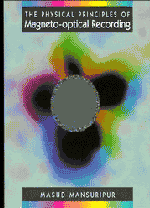Book contents
- Frontmatter
- Contents
- Preface
- 1 Overview of Optical Data Storage
- 2 Optics of Gaussian Beams
- 3 Theory of Diffraction
- 4 Diffraction of Gaussian Beams from Sharp Edges
- 5 Optics of Thin Films and Multilayers
- 6 Magneto-optical Readout
- 7 Effects of High-numerical-aperture Focusing on the State of Polarization
- 8 Computer Modeling of the Optical Path
- 9 Noise in Magneto-optical Readout
- 10 Modulation Coding and Error Correction
- 11 Thermal Aspects of Magneto-optical Recording
- 12 Fundamentals of Magnetism and Magnetic Materials
- 13 Magnetostatics of Thin-film Magneto-optical Media
- 14 Mean-field Analysis of Amorphous Rare Earth–Transition Metal Alloys
- 15 Magnetization Dynamics
- 16 Origins of Coercivity
- 17 The Process of Thermomagnetic Recording
- 18 Media Characterization
- References
- Index
1 - Overview of Optical Data Storage
Published online by Cambridge University Press: 07 September 2010
- Frontmatter
- Contents
- Preface
- 1 Overview of Optical Data Storage
- 2 Optics of Gaussian Beams
- 3 Theory of Diffraction
- 4 Diffraction of Gaussian Beams from Sharp Edges
- 5 Optics of Thin Films and Multilayers
- 6 Magneto-optical Readout
- 7 Effects of High-numerical-aperture Focusing on the State of Polarization
- 8 Computer Modeling of the Optical Path
- 9 Noise in Magneto-optical Readout
- 10 Modulation Coding and Error Correction
- 11 Thermal Aspects of Magneto-optical Recording
- 12 Fundamentals of Magnetism and Magnetic Materials
- 13 Magnetostatics of Thin-film Magneto-optical Media
- 14 Mean-field Analysis of Amorphous Rare Earth–Transition Metal Alloys
- 15 Magnetization Dynamics
- 16 Origins of Coercivity
- 17 The Process of Thermomagnetic Recording
- 18 Media Characterization
- References
- Index
Summary
Introduction
Since the early 1940s, magnetic recording has been the mainstay of electronic information storage worldwide. Audio tapes provided the first major application for the storage of information on magnetic media. Magnetic tape has been used extensively in consumer products such as audio tapes and video cassette recorders (VCRs); it has also found application in the backup or archival storage of computer files, satellite images, medical records, etc. Large volumetric capacity and low cost are the hallmarks of tape data storage, although sequential access to the recorded information is perhaps the main drawback of this technology. Magnetic hard-disk drives have been used as mass-storage devices in the computer industry ever since their inception in 1957. With an areal density that has doubled roughly every other year, hard disks have been and remain the medium of choice for secondary storage in computers. Another magnetic data storage device, the floppy disk, has been successful in areas where compactness, removability, and fairly rapid access to recorded information have been of prime concern. In addition to providing backup and safe storage, the inexpensive floppies with their moderate capacities (2 Mbyte on a 3.5″-diameter platter is typical) and reasonable transfer rates have provided the crucial function of file/data transfer between isolated machines. All in all, it has been a great half-century of progress and market dominance for magnetic recording devices which only now are beginning to face a potentially serious challenge from the technology of optical recording.
- Type
- Chapter
- Information
- The Physical Principles of Magneto-optical Recording , pp. 1 - 57Publisher: Cambridge University PressPrint publication year: 1995



